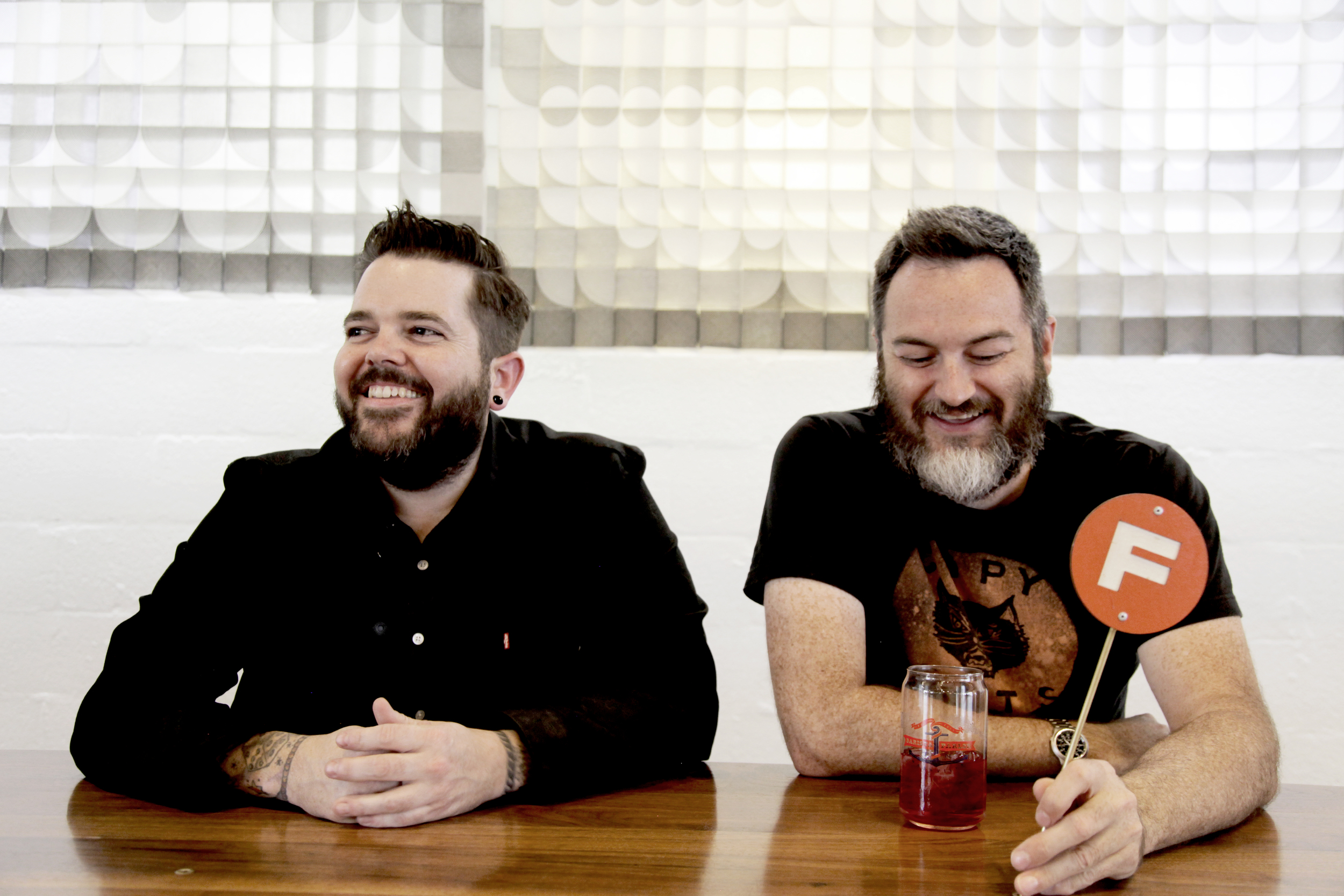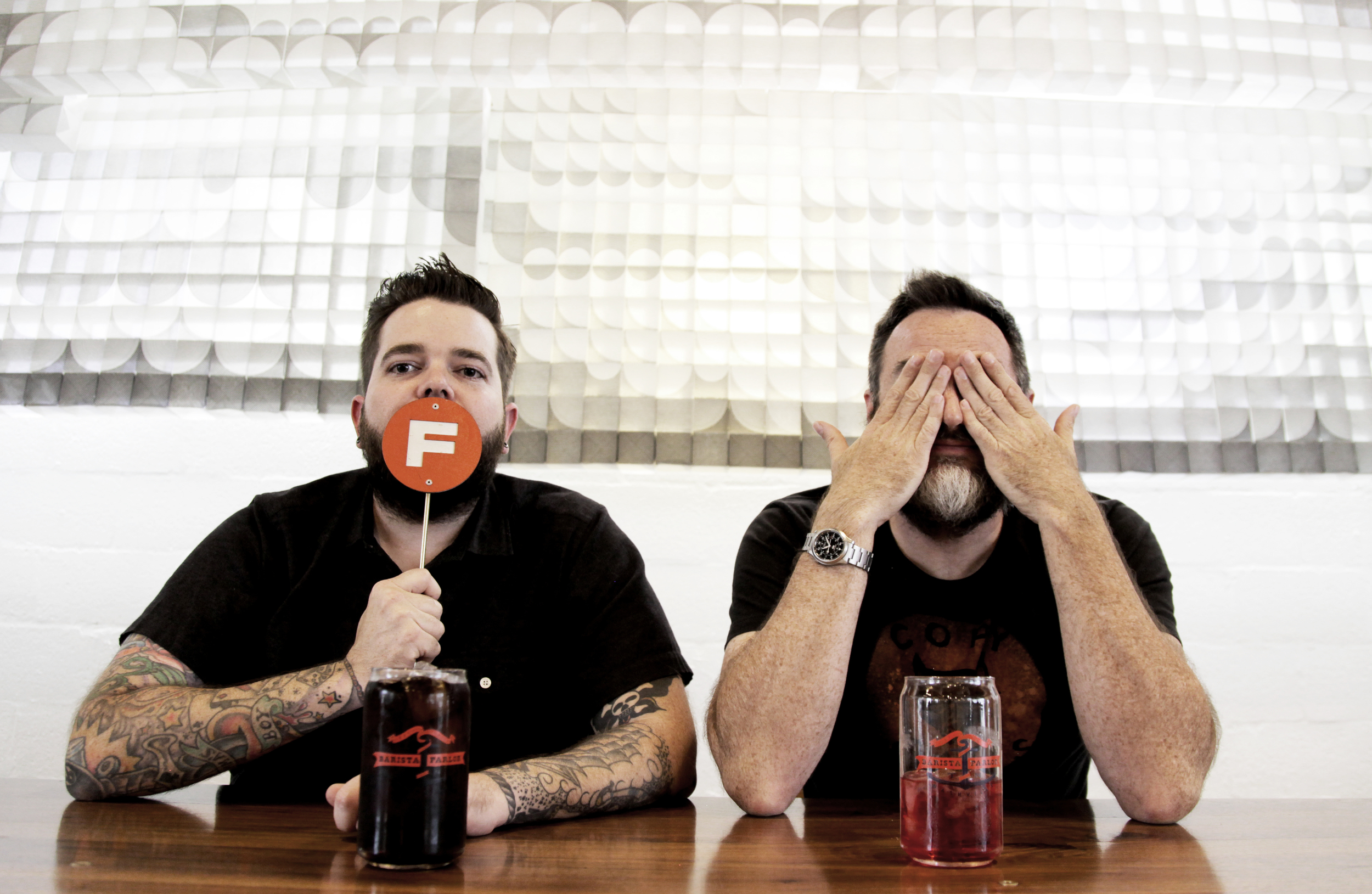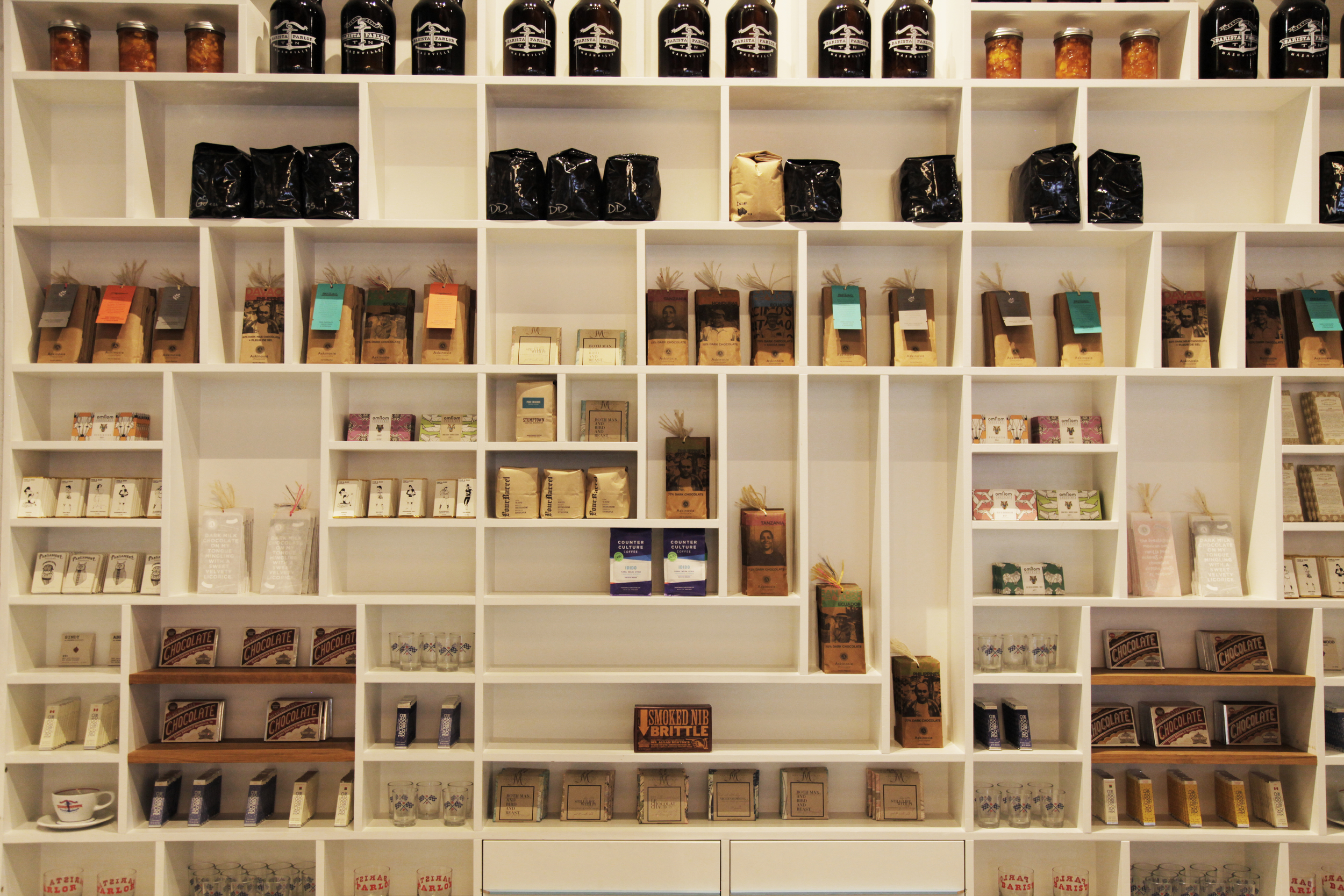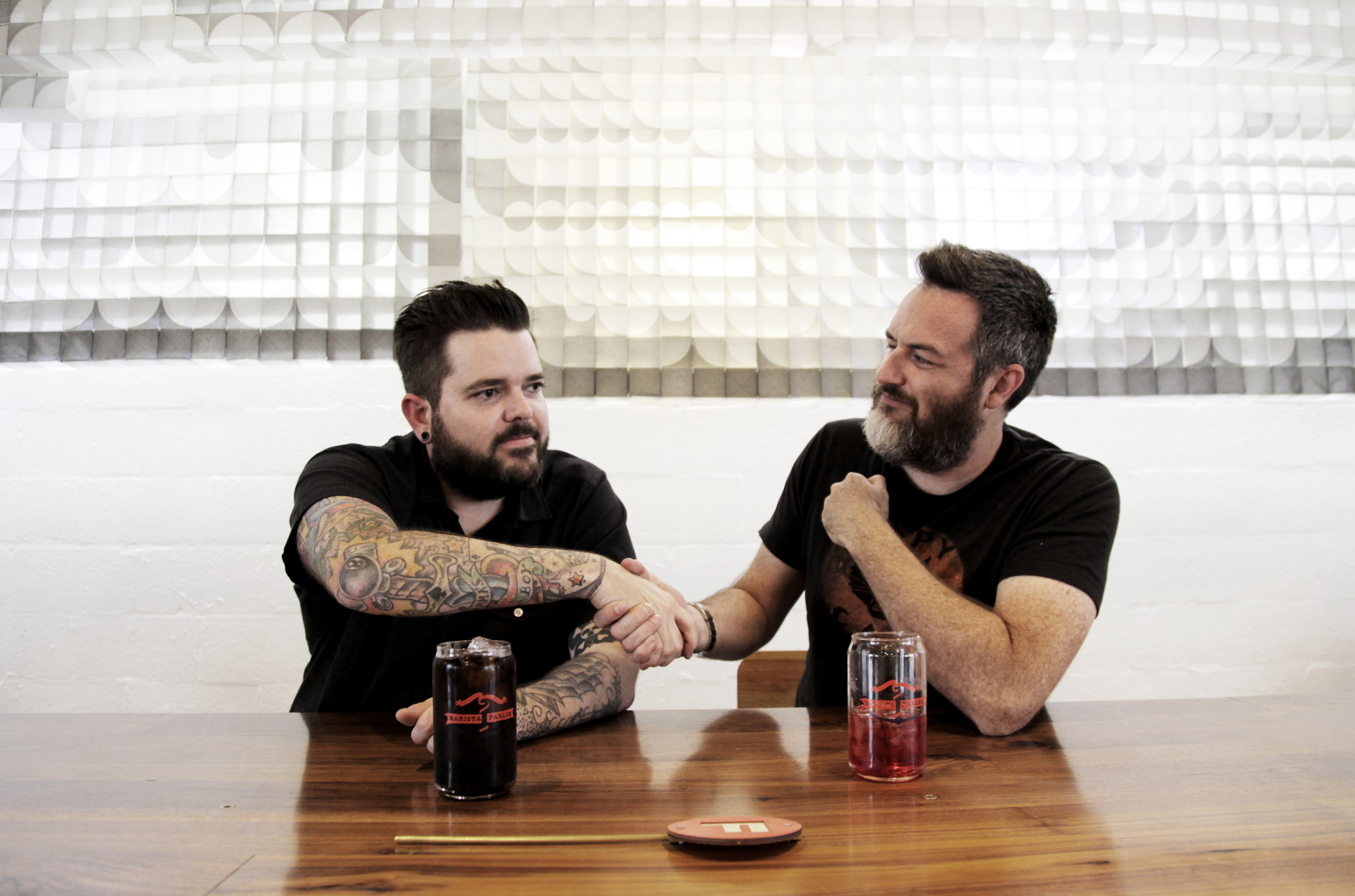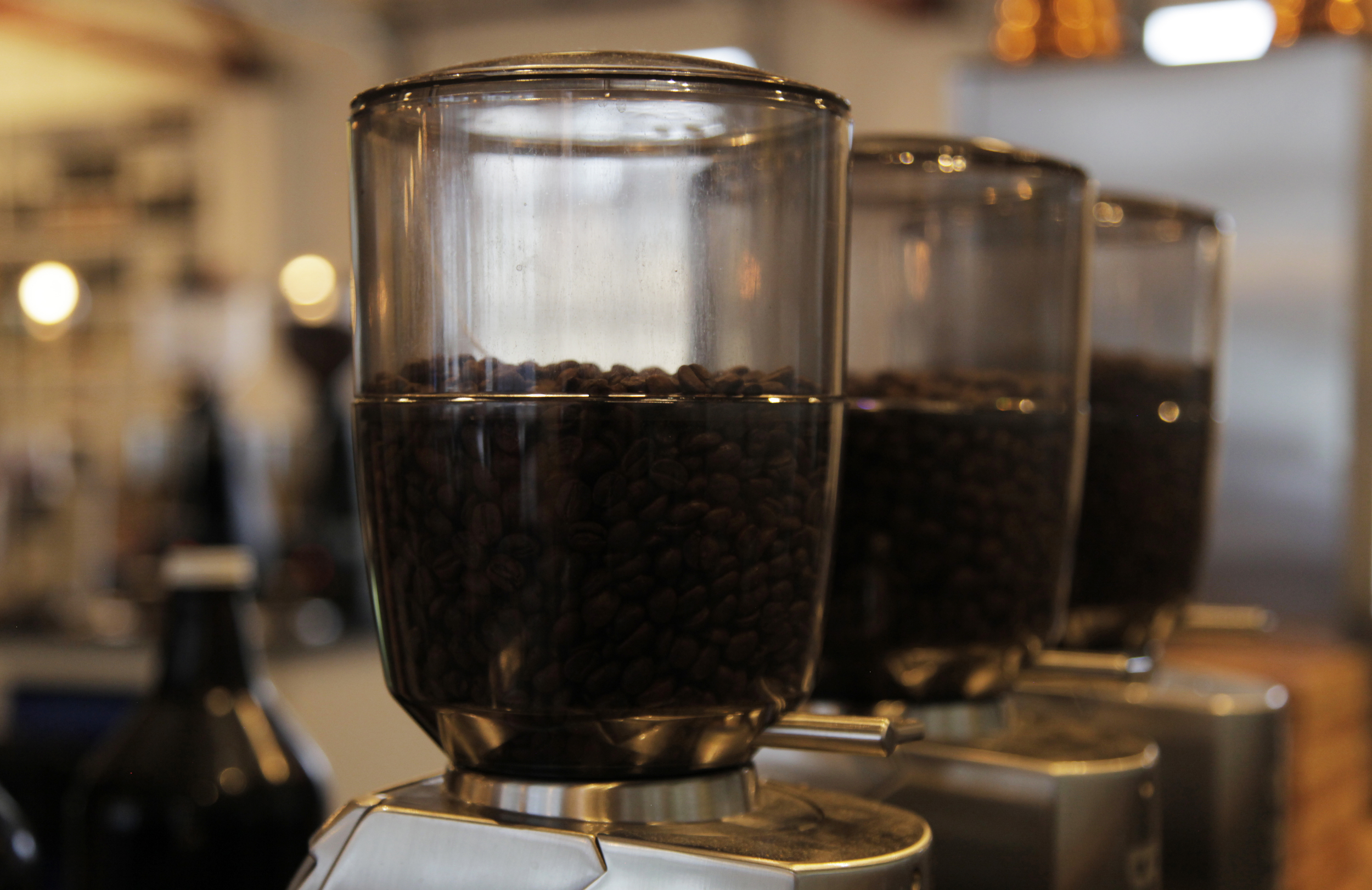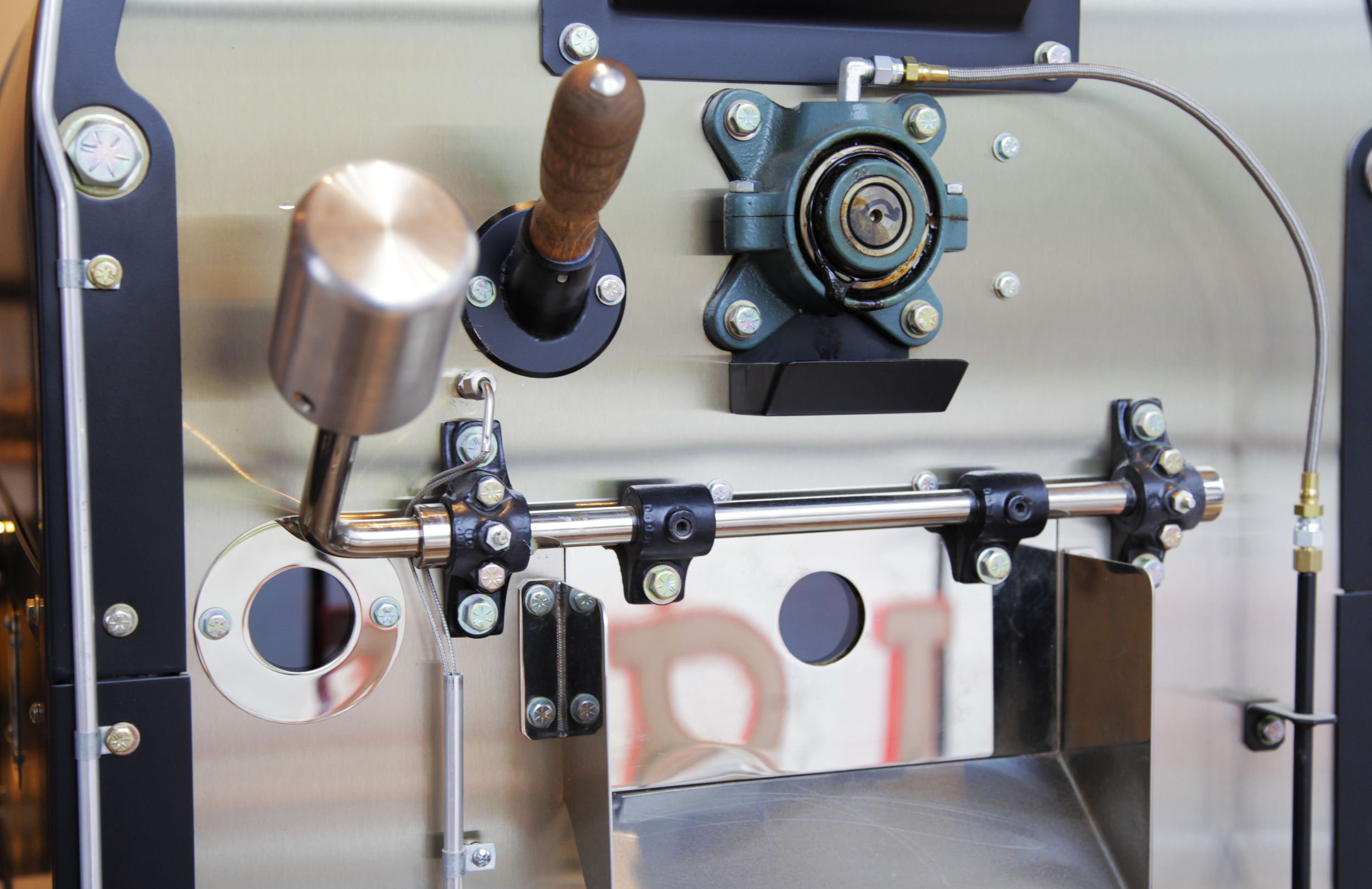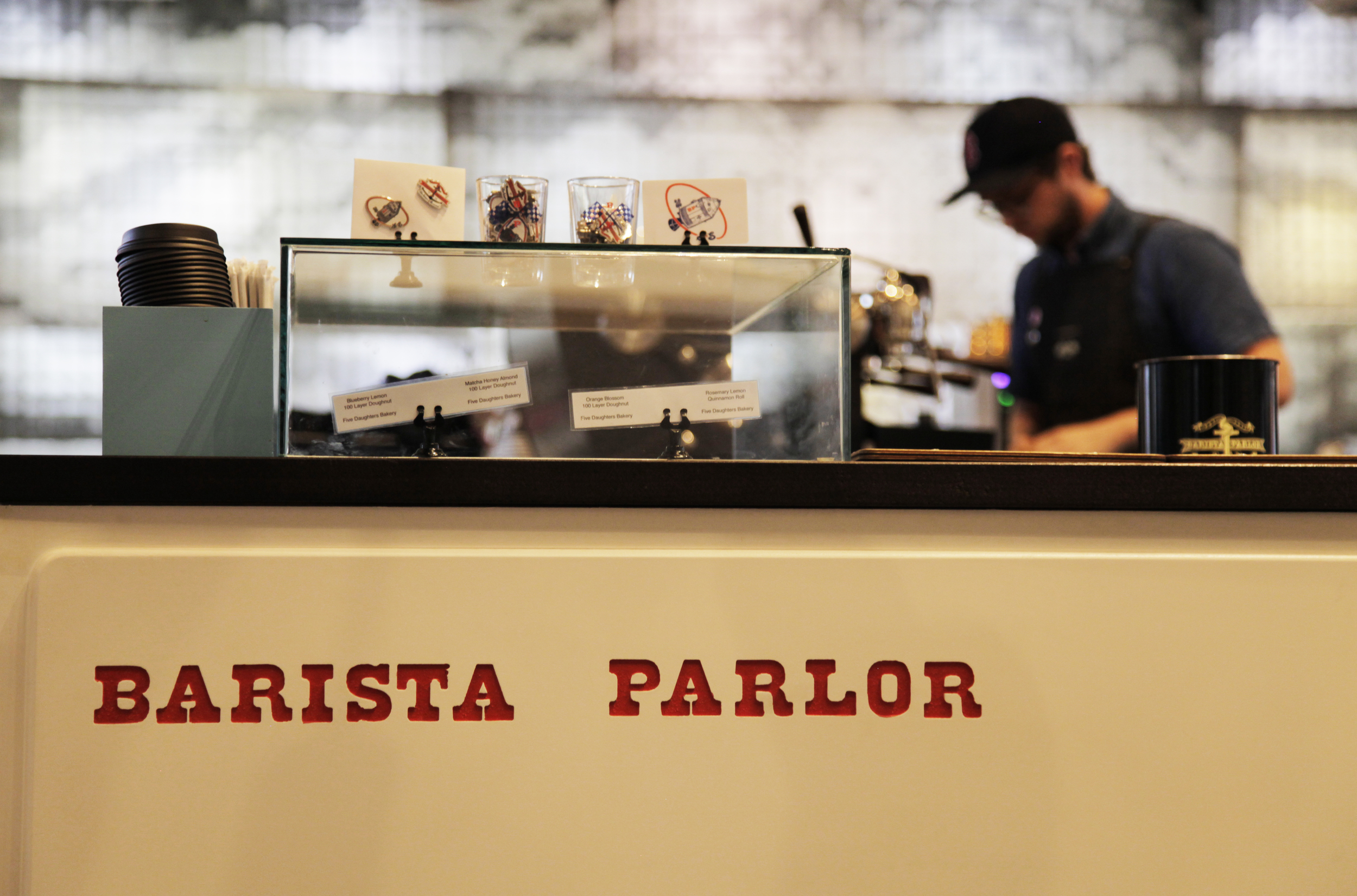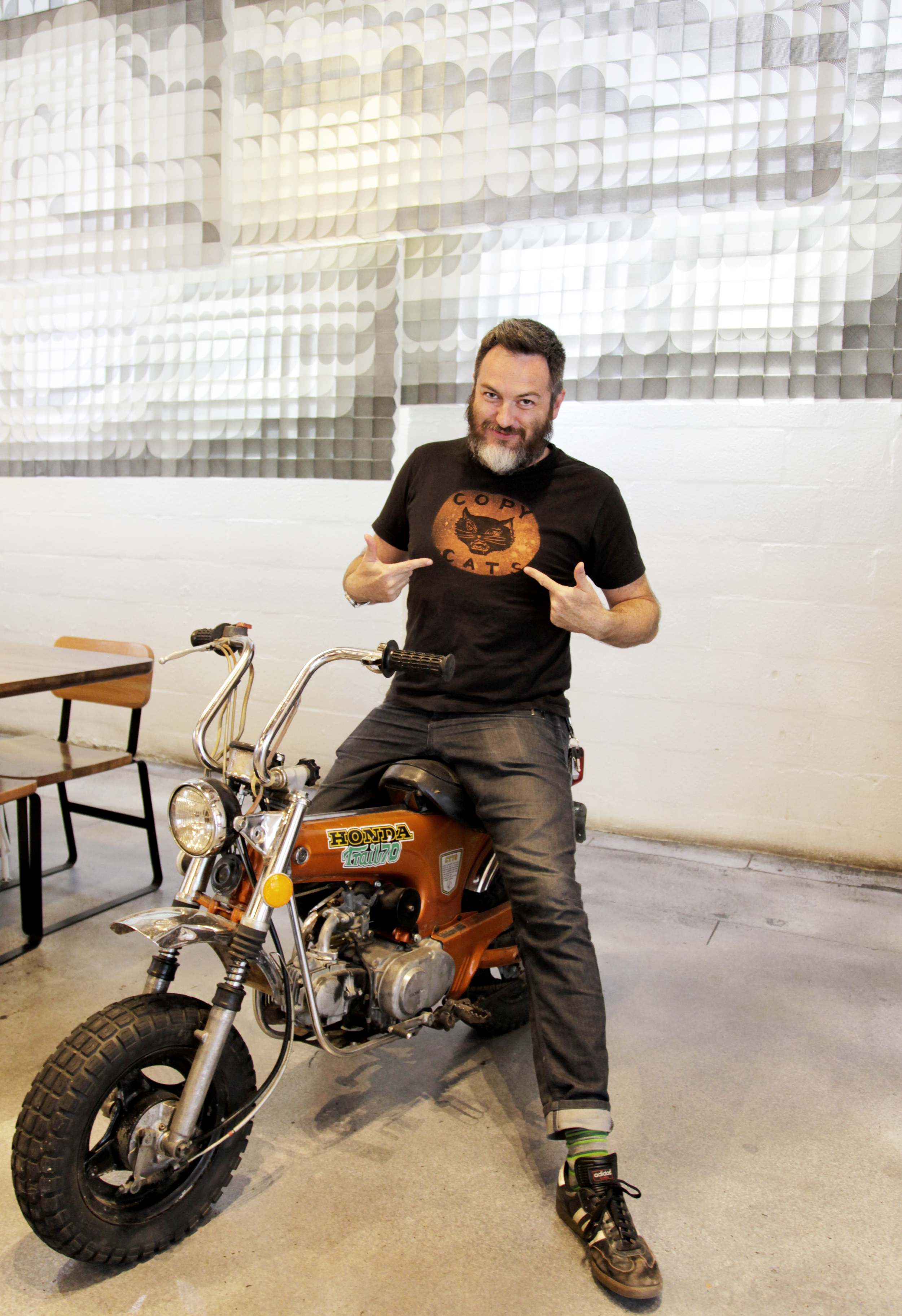Bryce McCloud of Isle of Printing & Andy Mumma of Barista Parlor
As I’ve said here before, Nashville’s bar scene is having a renaissance. At the same time, our coffee culture has entered its golden age.
Over the last several years, the local roasting community has exploded, with stalwarts like Bongo Java and Drew’s Brews joined by the folks at Crema, Roast, Inc., Steadfast, Honest and, as of earlier this year, Barista Parlor.
You can already order selections from Barista owner Andy Mumma’s new collection of roasts off the menu in one of his three shops, located in East Nashville, the Gulch and, as of earlier this year, Germantown. Later this month, he’ll introduce take-home packaged beans, which will be sold in one of the three BP locations and online before expanding to other retailers. (Look for a follow-up story about this very special project on The Callaway Report soon.)
But perfect lattes are only half the story at Barista. You come to the shops for the intricately considered cups of coffee, but you stay for the fun, eclectic atmosphere inspired by the art. This is the work of Andy and his creative conspirator, Bryce McCloud, mastermind behind the local creative oasis Isle of Printing. Together, they have established a very special symbiotic coffee/art mash-up, and, in in doing so, created some of the most memorable public interiors in Nashville’s recent history.
While they all share the distinction of being large, open spaces with garage doors, filled with cool old motorcycles and gorgeous long tables by third-generation Shelbyville craftsman Aaron Rosburg, the three Barista Parlors also share an over-arching leitmotif: transportation, which is evident by the art associated with each. East, devoted to travel by sea, features the Preussen, a 24-foot piece made up of 4,000 letterpress squares, each printed with a different ocean creature. The Gulch location, which sits in the former Golden Sound music studio, has an “air” theme that is paid homage by the spacecraft on the shop logo and the huge undulating cloud installation, made from thousands of translucent origami boxes lit from behind. The new Germantown location plays on travel by land, which is given a nod by the hot-rod painted on the window; its primary visual piece de resistance is still being conceived.
Andy and Bryce have been friends since the late ‘90s and have been working together on creative projects since Barista East opened in 2012. It was a seminal experience for each of them, and one that set them on a collaborative path that has no end in sight. Concept coffee shops and cool packaging are only the beginning.
Last week, Andy and Bryce sat down with TCR at Barista Germantown to sample a taste trifecta of biscuits, chocolate and coffee and talk about their personal and professional history, their ideas about the philosophy behind art in public/private spaces, and the metaphysical metaphors implicit in Barista’s transportation theme. A week later, they joined photographer Jo McCaughey at Golden Sound for a photo session. Enjoy both here.
This interview has been edited and condensed.
TCR: Let’s start at the beginning. When did you guys meet?
ANDY: Years and years ago. We had a lot of mutual friends, and probably the first time we met was at Robert's or something.
BRYCE: Yeah, some hazy, pre-smoking ban day.
ANDY: The crowd of folks that I met and hung out with when I moved here was the crowd of folks that Bryce grew up with. Nashville is still kind of a big small city, but it was a much smaller city then.
BRYCE: There just weren’t that many options. I was trying to explain that to somebody the other day. Back then if you had any progressive ideas, you were bound to run into each other.
ANDY: It’d be at the honky tonks, or it’d be like, at Lucy’s Record Shop.
BRYCE: There weren’t 50 bazillion options of places to be. And I think that was kinda cool ‘cause you met people doing all different things. The common things that make Nashville Nashville, like the honky tonks or whatever, inevitably have that crossover.
ANDY: Bryce was already making amazing art and posters, and I’ve always been blown away by his ability. It was some years later that we actually talked about (working together). Because you know, I’ve just always been a full-time barista, just working towards something. But it was years before I talked to him about trying to make this coffee bar happen.
TCR: When did you first have the idea to open Barista Parlor?
ANDY: About seven or eight years into my coffee career, I decided I’d really love to have my own place. And then it took me another seven or eight years to actually make it happen. It wasn’t just an overnight deal. I mean, we opened-opened in 2012, but it was 2010 when I was pretty much, I’m sick of this, I’m just gonna make it happen. That’s when I really kicked it into gear.
TCR: Did you immediately know that Barista was going to be this fusion of coffee and art?
ANDY: No, not until Bryce really got involved. But that’s with everything. I’ve been able to let things organically happen.
I wanted a big art piece on the wall at East. I never thought it would turn out to be what it is. That was the beginning.
[Speaking to Bryce] I remember sitting on the bench in the space, and looking at the wall with you, just kinda talking out ideas. And that’s when Bryce thought of the crazy letterpress pixilated squares. And from then on it’s just kind of been its own thing.
TCR: What does your collaboration process look like?
BRYCE: [Speaking to Andy] You were telling me about the space and said come look at this wall. And there was a conversation that we had based on that.
(At the beginning of any project) I get into a space and I listen to the dreams of the people around me. I just sit and I try to take it all in. I feel that you have to be an antenna, and just listen. There are signals that come in. And then they start to coalesce. I mean, that was a huge space. And that was really the first time that I had it as an idea.
TCR: You’re talking about the Preussen?
BRYCE: Yeah. How do you use letterpress to fill such a big space, because letterpress printing is usually for business cards and stuff like that. You’re limited by the size of the press, typically.
I’ve always been interested in doing public art, and I’d been doing it in different ways. But with Andy, we were just simpatico. After we started talking we realized that (the Barista Parlor space) was about coffee and it was about art. But it was really about creativity and making a place that people felt alive in.
I really like that it (the creation of the Preussen) was a collaborative process, ‘cause I worked on it with a friend who was here for a couple years from Italy. She’s a really talented designer. We designed the piece and then a bunch of people came together to assemble it. I thought that was a cool aspect of it, that it was kind of a community project.
TCR: Even though it was for a private business.
BRYCE: Exactly. And I don’t want to speak for you Andy, but even though Barista Parlors are technically private spaces, I’ve always thought of them as civic spaces -
ANDY: Oh yeah, absolutely.
BRYCE: - where creative ideas are generated. Especially in the early days of Barista Parlor East, that was really where you went to have ideas. How many things that are happening now (in Nashville) were first drawn on a napkin there? I feel like that was where the epicenter of this creative boom happened. I don’t want to make it sound like we’re taking credit for it, but I’d like to think that we were trying to give people an elevated experience. That was definitely on our minds: how can we make this space inspiring to people.
TCR: Maybe it’s because I know how you guys have worked so closely, but to me Barista Parlor has always stood for teamwork and collaboration. Andy, we were talking earlier about how you’ve assembled a team that you really trust to run things for you – same with you, Bryce. They’re your partners in crime. They are a big part in pushing your mission forward, by keeping things ticking. This is not just a one- or two-man project.
BRYCE: Man, Andy and I took a trip together, which was incredibly inspirational. We went and saw the Saturn V rockets in Huntsville, and one of the coolest things to me was not only seeing the rockets but some of the docents were actually scientists and engineers that worked on building that thing.
I think about it all the time. You know, some dreams you can accomplish by yourself, but when you start talking about changing the world or pushing culture in a new direction, it’s not just a one-person operation. And you have to really figure out how to work together as a team. I think for me it was so interesting and inspiring to learn about how those folks, under really tight deadlines, invented new technology that somehow went from not knowing how to put men in space to landing them successfully on another planet. No big deal. I feel some of the same things working with people like Andy.
ANDY: It takes people to make it happen. In reality, you can’t do it on your own.
BRYCE: Yeah, exactly. The coolest part is people bringing talents and ideas (to a project) that you would never have had just sitting there by yourself. The project is the sum of a group. A healthy and dynamic group is always greater than one person. I don’t know why that works, but two people can get three people’s work done if it’s the right people.
And I think we’ve been really lucky in that. I liked working on the first Barista. I think it was one of the best creative experiences that I’ve had in my life.
ANDY: It was life changing for me, too.
BRYCE: It was so collaborative and there was no ego. I remember we’d be talking through ideas and you know, everyone would throw out an idea and the one that seemed right, we would all go with it. It didn’t matter whose idea it was. The best one was the one that we did and we just went for it.
ANDY: Yeah, and within the Preussen there were probably 100 different ideas to make that thing work, stuff that you’d never think about, that would come up. At Golden Sound there were a lot of new things that we did with the cloud wall, but we had learned a lot from our first experience. The Preussen was totally experimental so you don’t really know (what you’ve learned) until you come up to another challenge.
In general, Barista Parlor is just an expression of what my idea of a coffee experience could be. That’s the beauty of coffee, that’s the beauty of art, and of commerce. I just want it to be different. I want people to think differently, so I wanted to have a different space, a different design, and have real art in it. There’s a difference between just decorating the walls and actually having some inspiring art.
But also what I love about this is having the freedom to do what we want. I mean, I’ve designed places that I want to hang out in and just hope that other people feel the same way. I’ve never designed them to be safe or to bring in the most revenue or anything.
BRYCE: I see the whole space as a giant piece of moving, kinetic art. All the people are part of it. The table markers are art. (“The Alpha Boys” are small men laser-cut in birch plywood and mounted on brass hardware; customers take them to their seats to help servers ID their orders.) Yeah, they’re little guys. But people carry them around and put them in different spots. So they become part of the art. When you step back and look at the whole place, the whole thing is constantly changing.
ANDY: After we got those going, I think that was one of the coolest things — just seeing people walking around with them, having them on the tables.
TCR: I never thought about it that way, a Barista space being a bigger piece of art that's constantly changing due to the movement of these smaller works. But then it makes sense; the community vibe you’ve created is entirely participatory.
I mean, people could ostensibly make the same cup of coffee they order here at home – and that’s especially true now that they’ll be able to buy Barista Parlor beans. But instead they choose to drink it there and to interact with their surroundings and each other in a very specific space. You don't come to Barista Parlor if you don't want to engage to some degree. This isn’t the kind of coffee shop where you come in, grab your coffee and zone out.
ANDY: Yeah, that’s what we want, for it to be less of a transaction and more of an experience.
BRYCE: I’m really into this idea of participatory art, but in a context where it happens organically. They’re just doing it and it’s happening in the best possible way, as part of life.
TCR: Even if they’d otherwise be unwilling to literally participate in the creation of art, by just being in the space they’re taking part.
ANDY: Yeah, you’re a part of it without knowing it. Also, there’s something more inclusive about carrying around this piece of art (the Alpha Boys) and putting it on your table than a metal marker. I feel like we try to do that kinda stuff everywhere.
TCR: It’s thought out. Everything is so well designed. Even the pipes running along the ceiling here are laid out in a beautiful formation.
ANDY: When we were doing Golden Sound, I met this electrician who did amazing conduit work. It was inside the walls, but I took photos of it – it was unbelievable. But of course it got covered up with dry wall. I knew that for the next project we were going to do something like this (the high-ceilinged, exposed space that is Barista Germantown) where we leave everything exposed. It’s really fun – a beautiful sculpture made out of conduit and it’s functional.
TCR: When did the whole transportation theme evolve? Was it when you started to work on Golden Sound?
ANDY: Yeah. That’s when the land, sea and air idea came about. After we got the Golden Sound building, it was impossible not to think about -
BRYCE: - how these things relate to each other. To me, transportation is so integral to the human condition. It’s what you think of moving from point A to point B in a physical sense, but I feel it in a spiritual sense, especially with the Preussen. I think it came to represent a spiritual journey from the physical to whatever is next. It’s a really nice metaphor.
You can take (the transportation theme) very literally, like we both love motorcycles and hot rods and muscle cars and old cool ships. Rockets. But, beyond that I think that these things as symbols are very powerful as well. I like that you can appreciate them for their physical beauty, but I also think it’s an interesting concept of how we go through space and time, physical space and I guess to whatever comes next.
ANDY: It’s neat having this arcing idea but being able to have branches and really do totally different stuff at each one. It’s been challenging, but also really fun. It’s what keeps me interested in building Barista Parlors. There was no way we would have three locations if I didn’t do that. Can you imagine if I just tried to build all three exactly like East? That would be so crazy. I could never design the same space over and over and over.
TCR: In other words, you will never become Starbucks.
ANDY: Yeah, I think that kinda defeats the idea of what we’ve started.
BRYCE: Each one of these has been an opportunity to try something different. I feel like we had a billion ideas for East, and then some of them got used (in the other shops). But really it always starts with the space, and then you just work it out from that. But it’s been fun to have that opportunity to create. It’s a very rare opportunity that you get to do multiple iterations of a concept.
ANDY: They’re all special, but East being the first one, everything was all totally new.
There’s one thing that happened then that I won’t ever forget. The night we finished the Preussen, Bryce and I were the last ones in the space. Our moms had both passed away recently. And it was a moment.
You know how Bryce was telling you the idea he has about the Preussen and crossing over? I think for me it symbolized the whole process of making that business happen. My mom passed away halfway through it, and I didn’t really think I was gonna be able to finish it. And Bryce was the same way. I feel like maybe it symbolizes this whole journey that they’ve gone through, and that Bryce and I are going through. That was definitely a moment I’ll never forget.
The darling Jo McCaughey is a Nashville-based photographer and filmmaker who has shot for Rolling Stone, The New Yorker, Vice and Vogue, not to mention Third Man Records, Saddle Creek and Infinity Cat. Until her website re-launches (soon - yay!), you can check out some of her spooky-gorgeous work on Instagram at @jojomccaughey.
